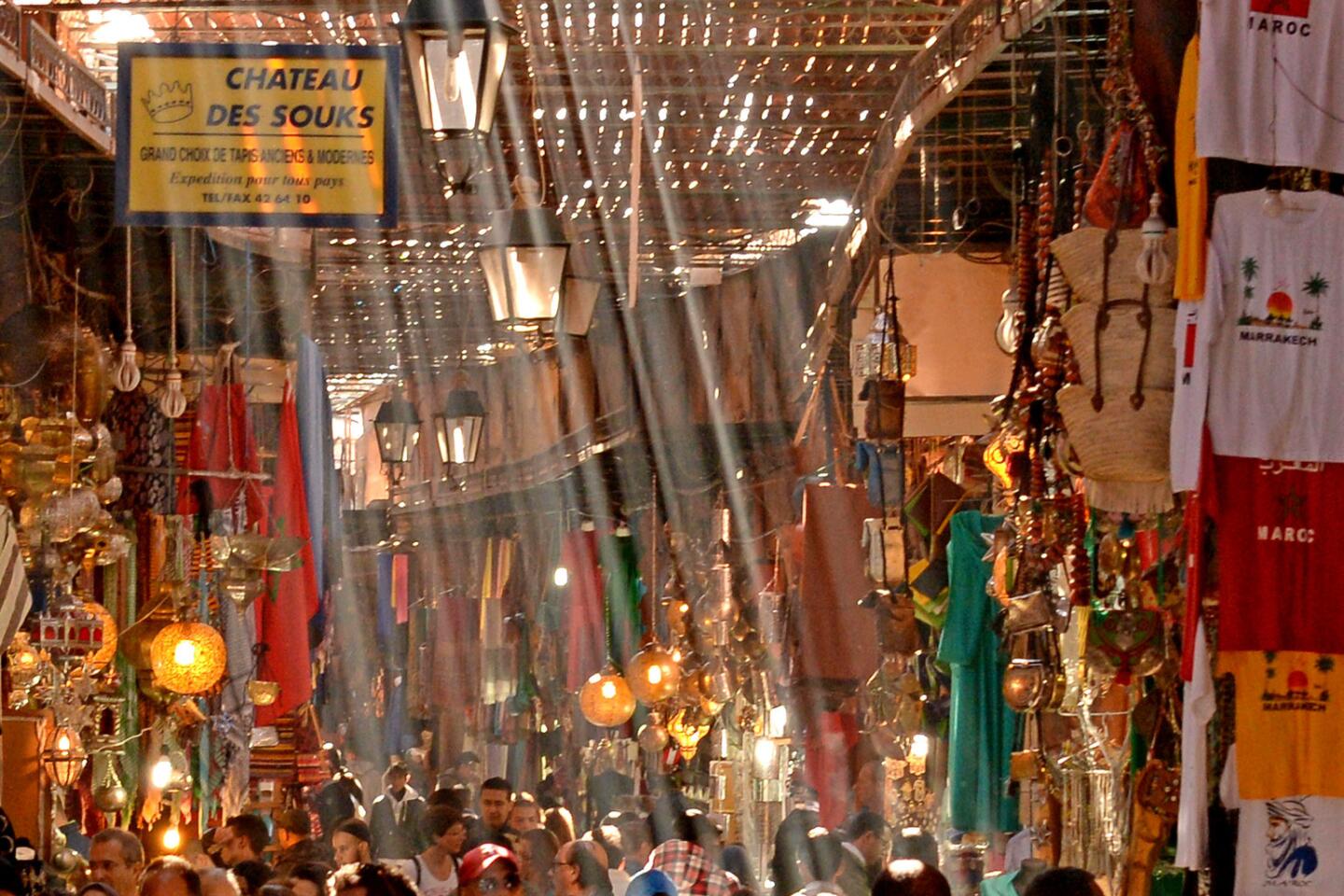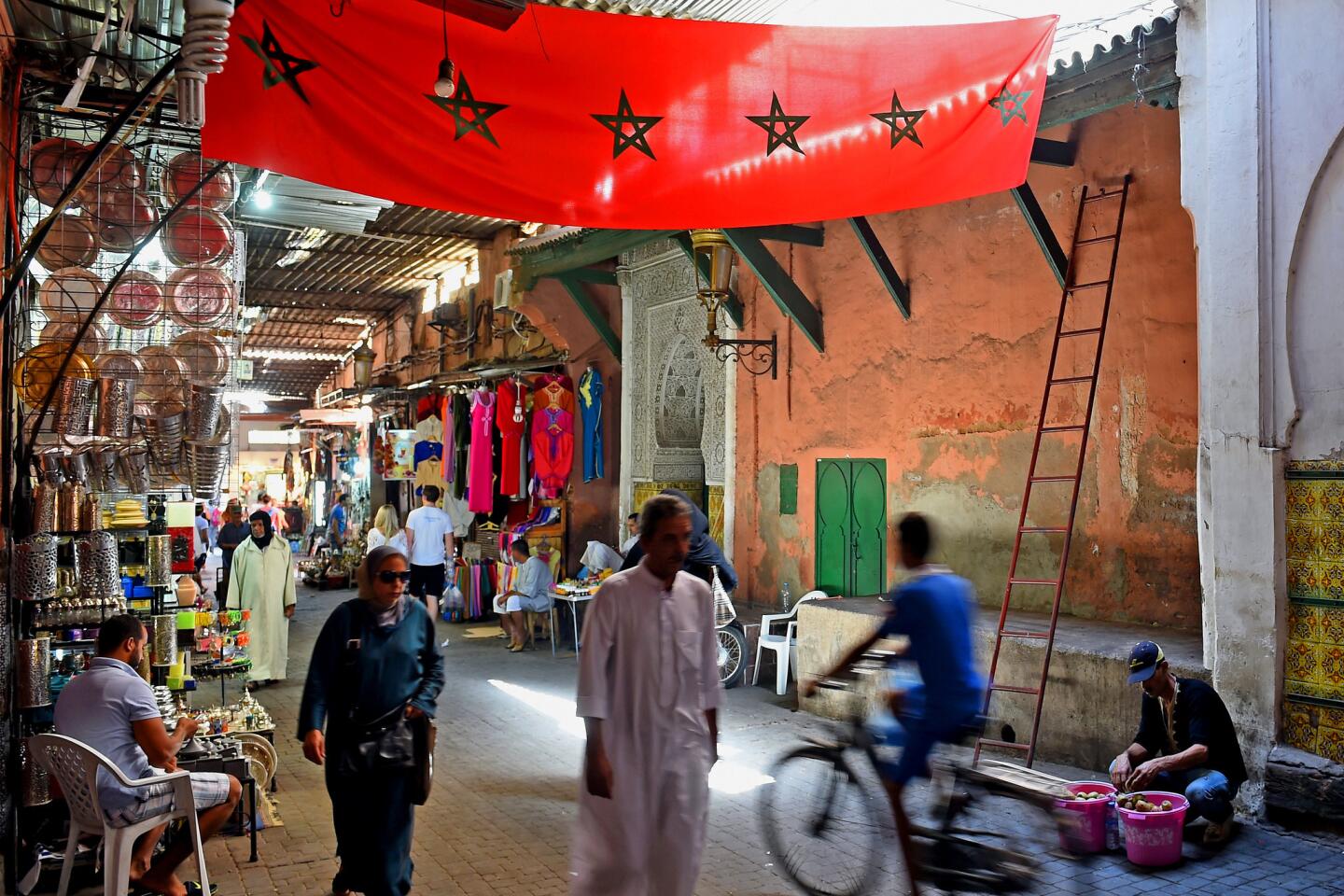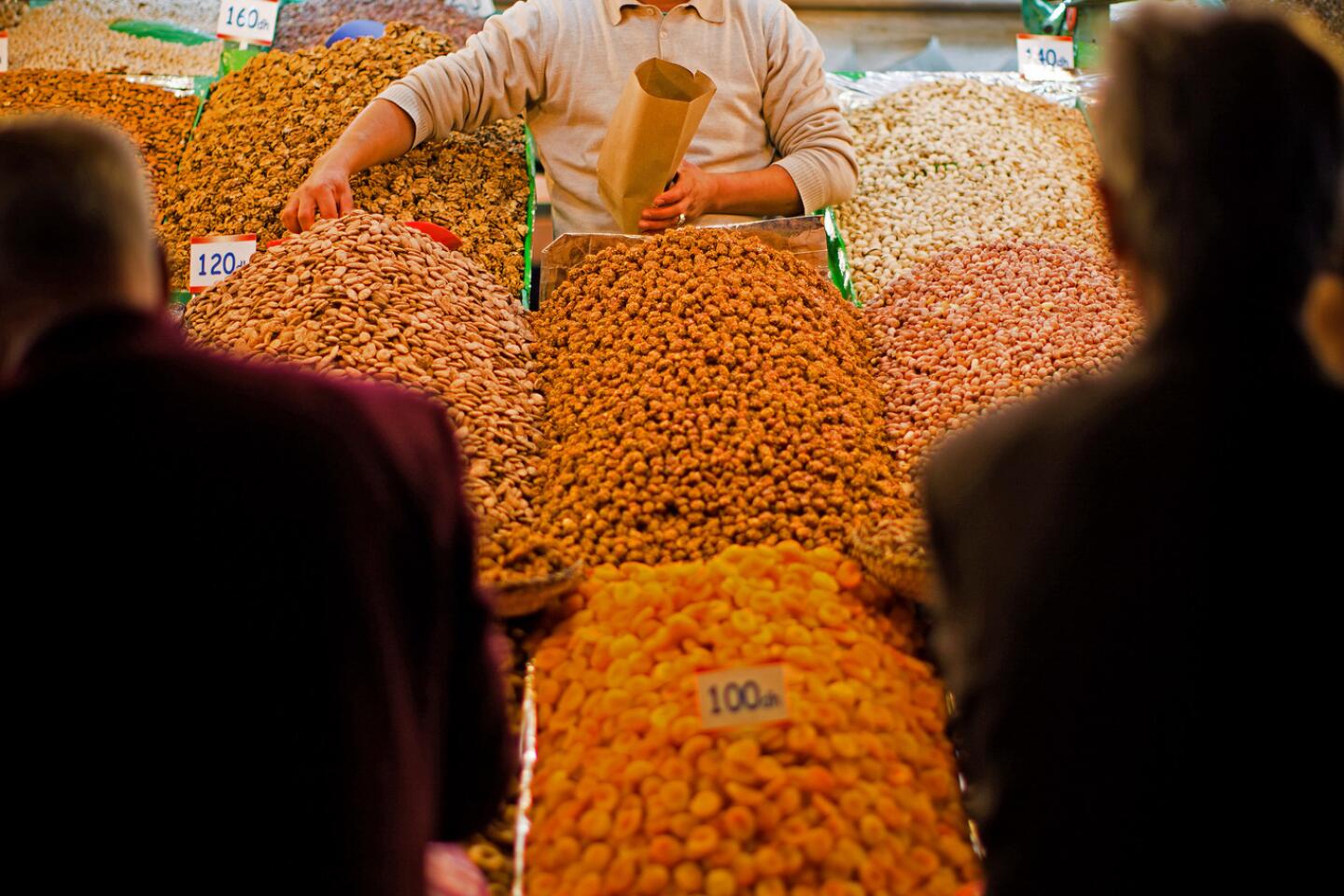Marrakech souks entice, but be prepared to haggle
- Share via
MARRAKECH, Morocco — Camera at the ready for my first wander around Marrakech’s labyrinthine souks, I was captivated by a pair of richly hued babouche slippers when a voice from over my shoulder startled me.
“I give you a good price,” the voice said. “It’s real camel skin. Two hundred dirhams” — a little more than $20.
I smiled and turned away from the man, who seemed to have materialized out of thin air. “I’m just looking, thanks,” I said.
“One hundred eighty dirhams,” he said, dropping the price by about $2. Seeing my continued disinterest, he persisted.
“How much you want to pay?” he asked, stepping in front of me.
That was my cue to leave — and a big clue that I had blundered badly on my first foray.
Each stride away from the apparition yelling prices at my back took me deeper into the dark souks. Someone barged past, knocking me into the path of a hefty man carrying three dead chickens by their feet. I managed to dodge him, only to be put on a collision course with a hurtling moped carrying three young men. I leaped out of the way just in time.
The shopkeepers proffering gaudy trinkets and cheap souvenirs seemed to grow increasingly noisy as I neared the thundering heart of the ancient medina and the throng of people intensified. Djemaa el-Fna, the central square, offered some respite, but the authentic atmosphere I sought was absent and lots of tourists were present.
A clamor arose: It was the adhan — the call to prayer — from the 12th century Koutoubia Mosque towering above the square, but by then I was too flustered to appreciate it. A sip of orange juice may have perked me up, but the sellers’ loud entreaties from behind a long bank of stalls added to my anxiety.
Far from traveling back to an age of mystery and wonder as I had imagined, Marrakech seemed like a parody of itself.
Hire a guide
Spring is an ideal time to visit the ancient North African gateway to the Sahara; the weather is pleasant without the oppressive heat of summer, and there are fewer tourists. But navigating the souks solo was less than ideal, even though the government has tried in recent years to reduce the aggressive selling through a mixture of education and law enforcement.
The key to a hassle-free experience, I learned, was a guide. On my second trip, I had Ali Ammata, a local man, at my side. We walked cautiously, lest we be maimed by the mopeds weaving and zooming through the crowds. “Why do you think so many people have their arms in casts?” Ali asked with a chuckle.
But no one was bothering me. A lone tourist clutching a chunky camera is a prime target for hawkers; one with a guide is not.
Ali, who worked at the Hostel Riad Marrakech Rouge where I was staying, had plenty of advice for keeping myself out of trouble. Indicating two bare-shouldered blonds wearing short shorts, he noted that covering up would eliminate much unwanted attention. An Australian he recently guided had been subjected to heckles, probably because of his tattoos (which Islam forbids), tank top and shorts, but after donning a T-shirt and buying some trousers, he ceased to be a target, Ali said.
Suddenly, I was conscious of my exposed legs.
The clothing shop Ali then led me to was little more than a narrow corridor, lined from floor to ceiling with a variety of harem trousers, thin and airy and ideal for traveling.
“How much should I pay?” I whispered to Ali after choosing a white pair with a subtle pattern. That all depended, he said, on what I was willing to pay, though as a rule of thumb the initial price could be three times greater than the final price.
The shopkeeper began negotiations at 200 dirhams, but we concluded business for less than half that price. It wasn’t a huge amount of money, but I felt enormous satisfaction at earning my haggling stripes.
I realized there’s no such thing as being swindled in Marrakech; decide what you’re willing to pay, then stick to it. Sure, it’s a world away from Western-style shopping, but it’s not about hoodwinking tourists; haggling is an ancient tradition, and participating is a cultural experience.
Deciding what to pay is difficult if you can’t distinguish good from bad quality. With Moroccan leather, which is made from goatskin, use your nose. If it has a strong odor, it probably has been treated with cheap products and the odor will proliferate. (You can always try sealing it with linseed oil.) Lining that’s tight against the leather suggests the item is well made.
As for Moroccan silver, look to pay 12 to 20 dirhams ($1.25 to $2.05) a gram. (Silver is sold by the gram and not by the piece of jewelry.) Any seller worth his salt should have scales to weigh it. Also, check that it has the 925 stamp to be sure it’s real silver.
Ali took me to quieter parts of the medina, through food markets brimming with fragrant spices and ripening vegetables, past craftsmen shaping wood, beating fiery metal and stirring dyes in vast pots.
After exploring a carpet shop where finely woven masterpieces covered every inch of the floor, we relaxed over refreshing mint tea with the shop owner, who serenely accepted that I was not buying today. (“But maybe tomorrow, sir?”)
I felt less a rube on my next solo venture (if a little silly in my harem pants), though one or two would-be guides did spot me as a potential client. But for the most part my naiveté seemed to have faded, helped perhaps by the fact that I wasn’t wearing the showy camera.
Know your price
My second turn at haggling began in a shop selling handmade wood crafts, most from the coastal town of Essaouira, Morocco’s woodwork heartland. Beautiful, but I couldn’t carry a globe or dining table in my luggage. I did have room for a “secret” box, though; its native thuya wood was lustrous, its hidden key revealed by uncovering a false wall.
The owner started high, but I wouldn’t budge from my “mental” price of 150 dirhams, about $15. I began to leave the shop, and he relented.
I was getting the hang of this.
When I reached Djemaa El-Fna, the square seemed different. It was full of locals gathered around snake charmers and magicians; the Marrakechi tend to go out in the early evening, avoiding the midday sun, which is why I saw so few on my first visit.
This time I confidently ordered orange juice, choosing a seller who squeezed it in front of me rather than pouring it from a container. Gulping down the zesty nectar as the adhan soared once more, I couldn’t believe I had looked upon Koutoubia’s glimmering minaret with anything less than amazement.
Later, I dined on pigeon pastilla (minced meat baked in pastry, dusted with cinnamon and sugar), followed by a tender, piquant lamb tagine at Chez Chegrouni, Ali’s recommendation. The handsome restaurant sparkled with enameled terra-cotta mosaics, yet the excellent food was less expensive, about $10, than elsewhere in the square.
Watching from the terrace as night fell on the now bustling Djemaa El-Fna, lamps burning and smoke rising from the grills, I sighed with contentment.
More to Read
Sign up for The Wild
We’ll help you find the best places to hike, bike and run, as well as the perfect silent spots for meditation and yoga.
You may occasionally receive promotional content from the Los Angeles Times.










